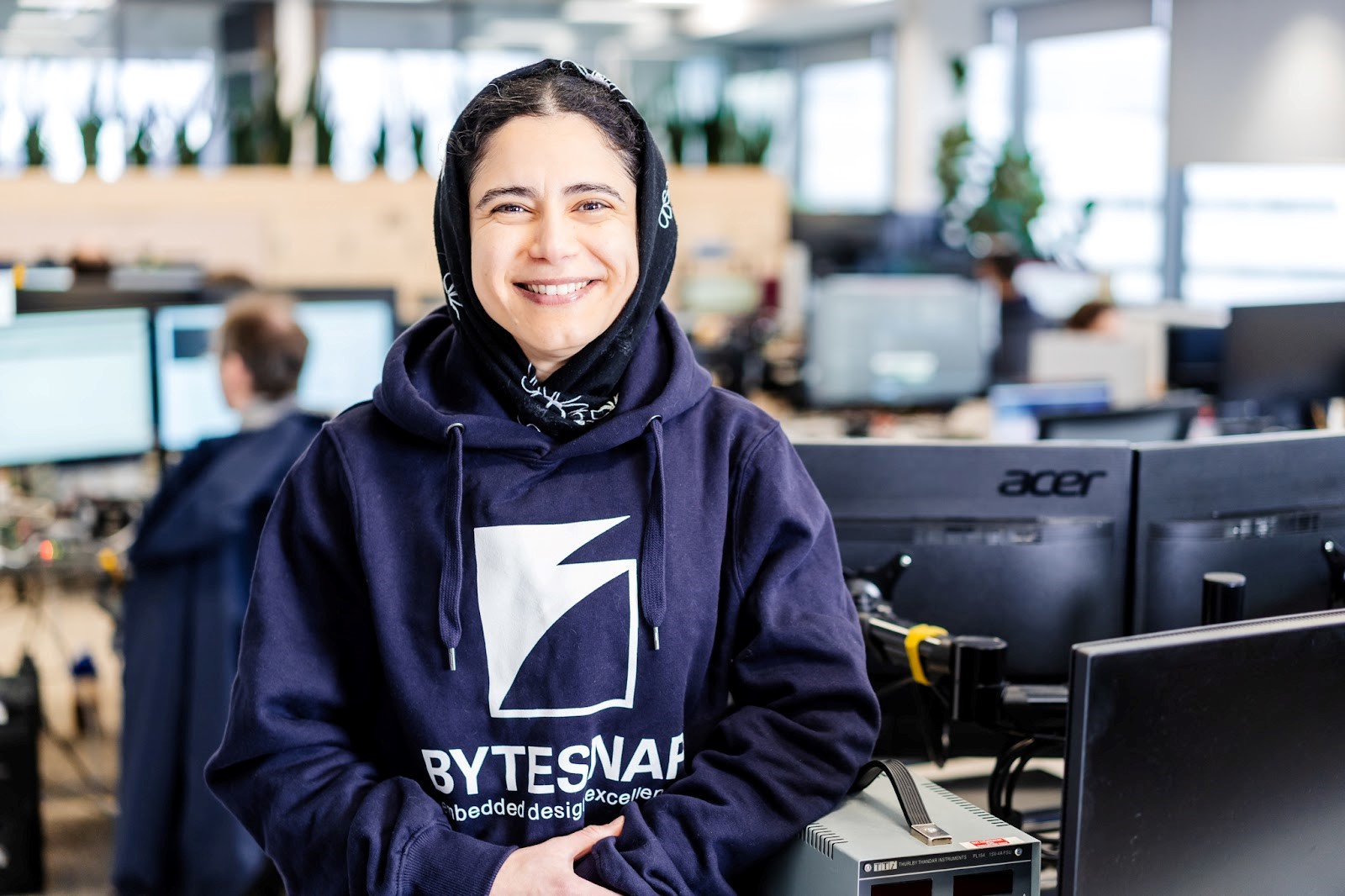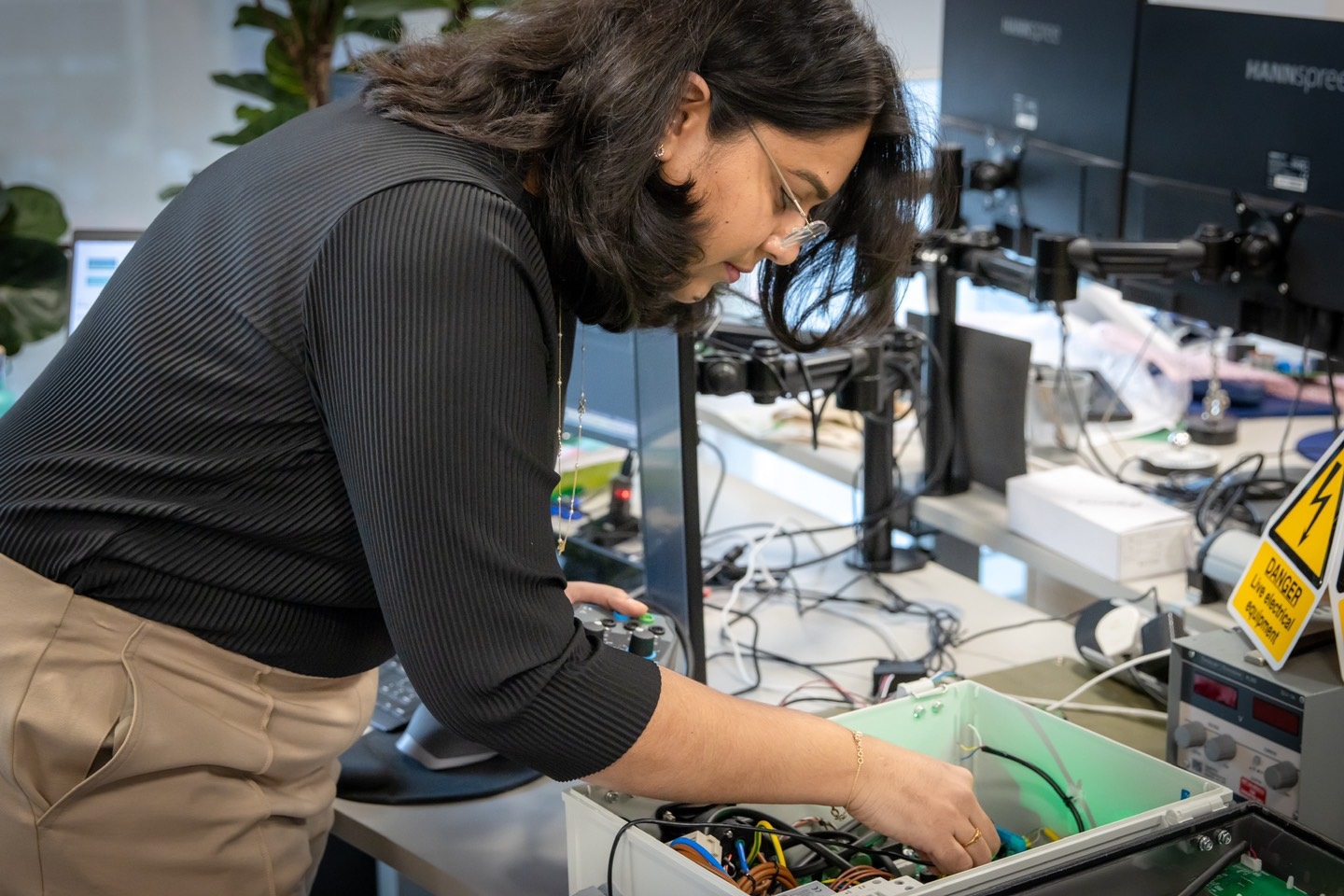Every year on 23 June, the teams at ByteSnap Design and Versinetic celebrate International Women in Engineering Day, recognising the incredible women who have dedicated their careers to using their maths and science skills to design, test and build amazing products that tackle real-world problems.
Manjuladevi Balasubramanian is one such incredible woman. She works as a software engineer at EV smart charging design and development firm Versinetic and was recently named “Returner of the Year” at the Women in Electronics Awards.
Her journey as a software engineer started in India, with a bachelor’s degree in engineering, followed by an MSc in Software Systems from the Birla Institute of Science and Technology, before relocating to the UK via a career break in Paris. Manjuladevi specialises in the embedded systems field, which incorporates hardware and software so curiosity, problem-solving and attention to detail are everyday requirements in her role at Versinetic.
Manjuladevi has been involved in some exciting projects since joining Versinetic, thanks to the expansive range of work and the different clients that the EV smart charging design and development firm is involved with. Some of the opportunities that Versinetic has offered Manjuladevi the chance to develop include an EV charger production tool to engineer a streamlined EV charger production process. This tool removed manual processing costs and helped to improve yield and quality. Another project that Manjuladevi was involved in was to design a collaboration tool that removed more than 12 minutes of manual intervention. This project achieved yet another well-engineered cost-saving tool for EV businesses.
Wanting to encourage more women into engineering, Manjuladevi has mentored others in optimising their CVs and interview preparedness. Her guidance has assisted several females secure their first engineering job interviews in years, providing a blueprint to resuscitate dormant careers. More formally, Manjuladevi’s insights on navigating technical skills erosion and interview barriers benefit returner training programs.
While Manjuladevi is a great example of a woman in engineering, she is not the only amazing woman currently working in the embedded electronics field. Magda Abdelbasit Abbas is an electronics engineer with ByteSnap Design. Thanks to the firm’s culture of innovation, collaboration and nurturing talent, there is regular promotion from within and all employees have room to grow. They also actively welcome people returning to work or anyone considering a career change.

Magda is one such example as she came to work with ByteSnap Design after switching career paths from her previous role as a teaching assistant. The switch in career came about thanks to her brother taking up mechanical engineering as Magda recognising the opportunity that would give her to use maths; a subject she enjoyed immensely and had a true talent for.
ByteSnap Design has already put Magda’s maths prowess to best use in several projects from creating circuit designs for embedded products and managing firmware for device tests and updates for all sorts of products, from food appliances to communications and complex media devices like pacemakers that help people to live. Every device relies heavily on embedded electronics engineering skills so it is a profession that in essence builds daily life.
Magda had the aim to create online resources on embedded systems in Arabic so that those material could be used as a starting point for students in Sudan or any other Arabic-speaking country. She writes blogs and content, including guides about the hardware and software platforms used to build embedded devices, which she continues to transcribe and share online so they can be used by anyone interested in learning more about those seeking to expand their knowledge base.
She thinks that every engineer has a contribution to make but that women in engineering may be required to work harder than their male counterparts, so they should gain requisite skills by working on open source early on in their careers, to contribute as juniors and establish their profiles in the engineering field and open source sector.
In 2023, men made up 86.3% of the global engineering workforce outnumbering female engineers (13.7%). While this percentage of women in engineering was a reduction from 14.88% in 2020, figures over the years indicate a general increase in the percentage of women employed in engineering worldwide.
In the UK, just 16.5% of engineers were women in 2022 – up from 10.5% in 2010, but that percentage dropped to 15.7% in 2023. The percentage of women working in engineering is surprisingly low considering how advanced the UK is in terms of gender equality policies, but this is something that can be changed. Role models such as Manjuladevi and Magda, alongside forward-thinking companies, like Versinetic and ByteSnap, are actively focused on attracting women back into the workforce. Both women mentor talented female engineers, while the companies work with universities to encourage students to think about applying for engineering roles with them. The companies are both growing rapidly thanks to promoting the uptake of engineering and working with aspiring engineering students on graduate-level software, hardware and robotic engineering projects.
Women continue to be underrepresented in engineering with electrical and electronics engineering having the lowest percentage of females. But there is a growing number of female students choosing engineering and technology undergraduate courses so mentoring is an important part of encouraging more girls interested in maths to consider engineering as a viable career path.
Magda says: “From my understanding, a big reason for girls in the UK not following an engineering path is their misplaced belief that they are no good at maths, and the image of a ‘hard hat’ associated with engineering. I would recommend exploring the broad range of engineering disciplines and careers to gain a better understanding of the type of opportunity that can be pursued, from chemical, civil, electrical to structural, mechanical and more, this is a broad field, and the opportunities are endless.”

Training is key and should be introduced at an early stage as, without attracting women of all ages to the opportunities that engineering offers, the lack of women in engineering is not a situation that is likely to improve without action. Female STEM students need to consider their future career prospects and Women in Engineering Day presents an opportunity to celebrate those females in engineering who are not only role models but are also creating awareness amongst those who might be considering a career in the industry.
It is also worth looking at some organisations and groups specifically set up to help women in engineering. Magda recommends Women Who Code (Womenwhocode.com), which is an interactive community made up of females who are learning programming. The Women in Engineering Society is another useful resource as the network helps with mentoring and promotes the uptake of engineering among female students.





